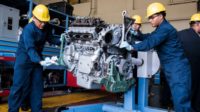Equipment
EPA Finalizes Stricter Heavy-Duty Engine Emissions Standards

U.S. EPA Administrator Michael Regan signs a rule setting stronger heavy-duty engine and vehicle emissions standards.
Photo courtesy of U.S. Environmental Protection Agency
Heavy-duty engines and vehicles will be subject to more stringent environmental standards starting in model year 2027 under a final rule signed by U.S. Environmental Protection Agency Administrator Michael Regan Dec. 20. The rule sets a new standard to cut smog- and soot-forming emissions from heavy duty vehicles by 50% over current levels by 2045.
The rule covers nitrogen oxide (NOx) emission from heavy duty gasoline and diesel engines. It is primarily targets on-highway vehicles, but it includes provisions covering engine categories like off-highway spark-ignition engines and compression-ignition engines that are used in some construction equipment. Regan called the new requirements “strongest-ever national standards” for the vehicle types covered by the rule.
The rule will extend the useful life of vehicles by 1.5 to 2.5 times longer and enable vehicles to meet more stringent emissions standards for 2.8 to 4.5 times longer compared to the current rule, according to EPA. Manufacturers also must ensure that their engines’ electronic pollution controls are tamper-proof. EPA also projects the standards will result in $29 billion in annual net benefits in public health such as reduced cases of childhood asthma, fewer lost days of work and up to 2,900 fewer premature deaths each year.
“This rule will result in widespread air quality improvements across the United States, especially in communities near major roadways that are overburdened by air pollution,” Regan said during an event celebrating the new standards.
Manufacturers’ groups had initially criticized the proposed rule earlier this year, but expressed a willingness to adopt the final rule’s standards. Jed Mandel, president of the Truck and Engine Manufacturers Association, said in a statement that the rule “will be challenging to implement” but that the group’s members are committed to it.
“Ultimately, the success or failure of this rule hinges on the willingness and ability of trucking fleets to invest in purchasing the new technology to replace their older, higher-emitting vehicles,” Mandel said.
Some environmental advocates said the rule is a positive step, but the standards do not go far enough to reduce NOx emissions. Britt Carmon, federal clean vehicles advocate at Natural Resources Defense Council, said in a statement that EPA “missed a critical opportunity to slash soot and smog” by still allowing some emissions.
“EPA now needs to move quickly to put in place the next round of standards that will accelerate the transition to zero-emitting trucks so that we can all be free from the tailpipe pollution that is harming our health and accelerating climate change,” Carmon said.
Regan said the final rule was just the first of three steps in EPA’s “clean trucks plan.” The agency will propose its next step by the end of March 2023, he added. EPA has said it would also set stronger emissions standards for medium-duty vehicles starting in model year 2027 and “significantly stronger” standards for heavy-duty vehicles as soon as model year 2030.
Additional rulemaking, along with funding to boost vehicle electrification through legislation like the Infrastructure Investment and Jobs Act and the Inflation Reduction Act, would further reduce smog and soot, according to EPA.
“While EPA standards will push heavy duty trucks to be cleaner, this administration's investments in cleaner trucks and cleaner technology will propel us further and faster than ever before,” Regan said.
EPA is also assessing waiver requests from California to set its own, stricter emissions standards. The agency says it will issue decisions on the waivers in early 2023.





